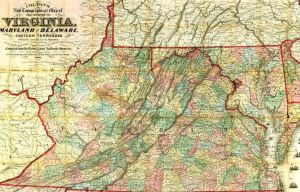 Today in Virginia’s Shenandoah Valley, far from the Union offensive against Richmond, Confederate General Jubal Early‘s forces defeat Federal forces near Winchester in the Second Battle of Kernstown. While the Confederacy wins this battle, it proves to be the last Rebel victory in the Shenandoah Valley. The Union defeat this day marks the beginning of Union General Philip Sheridan‘s Valley Campaign, an effort to destroy the breadbasket of the Confederacy. Should this year’s Southern crops in the valley be destroyed, a long, hard and hungry winter will await the defenders of Petersburg and Richmond.
Today in Virginia’s Shenandoah Valley, far from the Union offensive against Richmond, Confederate General Jubal Early‘s forces defeat Federal forces near Winchester in the Second Battle of Kernstown. While the Confederacy wins this battle, it proves to be the last Rebel victory in the Shenandoah Valley. The Union defeat this day marks the beginning of Union General Philip Sheridan‘s Valley Campaign, an effort to destroy the breadbasket of the Confederacy. Should this year’s Southern crops in the valley be destroyed, a long, hard and hungry winter will await the defenders of Petersburg and Richmond.
Meanwhile in Charlottesville this month, in Virginia’s Albemarle County, the racial tension within the city’s First Baptist Church mounts in the face of the falling fortunes of the Confederacy. Like many other First Baptist congregations of the South, the white leadership of the yet-integrated church realizes the precariousness of the times. Union armies are nearby, and slaves within the city are increasingly running away to the safety and freedom that awaits behind Federal lines. Almost as troublesome is the fact that the free black population of Charlottesville is growing increasingly exertive, and sometimes rather defiant, in church life.
So it is that this month several free black members of the First Baptist Church challenge white control over the church’s African congregation. Comprised of enslaved and free blacks, the congregation is carefully overseen by a white preacher who is charged with making certain that matters do not get out of hand. The disgruntled free blacks threaten to start their own independent church, but soon back down when the white congregation forbids the independence of black members.
Their time has not quite yet come for independence for all blacks, but many enslaved Baptists–as well as free blacks living in the South–believe Union victory is inevitable, and quietly rejoice away from the presence of whites.
Sources: Second Battle of Kernstown (link) and (link); Edward L. Ayers, Gary W. Gallagher, Andrew J. Torget, editors, Crucible of the Civil War: Virginia from Secession to Commemoration, University of Virginia Press, 2006, pp. 154-155 (link)


